By Periklis Deligiannis
 An Osco-Attic helmet of the Lucanians with many characteristic Oscan novelties.
An Osco-Attic helmet of the Lucanians with many characteristic Oscan novelties.
–
Etruscan hoplites of Tarquinia with Greek arms and armour, 4th century BC. The hoplite on the right wears a proper Attic helmet. The left one wears a mixed Phrygo-Attic helmet.
–
The peoples of ancient Italy, firstly the Etruscans and the Iapyges (later known as ‘Apulians’), used almost all types of the Archaic, Classical and Hellenistic Greek helmets: the Corinthian, the Chalkidean, the Attic (Athenian), the Boeotian (for the cavalry) and later the Thracian, the Phrygian and all the Hellenistic types. They had particular preference for the first three types. In this article, I will deal specifically with two types of helmets in Italy which originated from the evolution of the original Greek respective ones: the Italo-Corinthian and the Italo-Attic or Osco-Attic helmet (in fact, the Osco-Attic is the main variety of the Italo-Attic group of helmets).
The Italo-Corinthian helmet (also known as Pseudo-Corinthian, Apulo-Corinthian or Etrusco-Corinthian ) was born out of the habit of the warriors of Italy to wear their Corinthian helmet raised, even when the battle began. Because of this, the protective visor gradually evolved into a decorative ‘pseudo-visor’ while the helmet was manufactured in a manner that did not cover the face anymore. In the later centuries, Attic-type cheek-protectors were added in it.
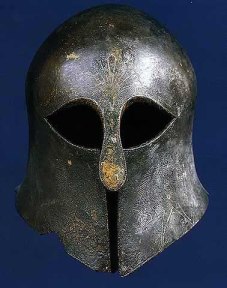
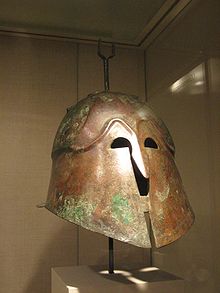
Top photo: the original Corinthian type .
Bottom: Italo-Corinthian helmet.
–
Until lately the archaeologists considered rather erroneously, the Etruscans as the developers of the Italo-Corinthian helmet, hence its original archaeological name: Etrusco-Corinthian. Lately it is evident that its creators were the Apulians (Iapyges in ancient Greek) of Southeastern Italy. (The Iapyges originated from the fusion of Illyrian colonists from the opposite coast of the Adriatic Sea with native Ausones and Oenotrians. Later the Iapyges were Oscanized because of Oscan settlers in their land, thereby becoming the Apuli (Apulians). Only the Messapians (Messapii) retained their original Illyro-Italian language). There were several varieties of the Italo-Corinthian helmet. The Etruscans, the Romans, the Latins, the Umbrians and the Iapyges were the peoples who used it more, but this helmet was generally popular throughout Italy.
The Attic helmet was equally esteemed by the Etruscans, who very often wore it with the cheek-protectors raised. This type of helmet has a course of over a thousand years which paradoxically belongs more to the Italian-Roman diachronic arsenal, rather than the Greek arsenal from which it originates. It was invention of the Athenians of the 5th century BC, and from the late 4th century BC it was spread throughout the Hellenistic and later the Greco-Roman world. At the same time, the peoples of Italy have adopted it massively. Gradually, it was established informally as a helmet of the senior officers. In Italy, the Etruscans and the Oscans developed their own Etrusco-Attic and Osco-Attic types. Also the Apulian Oscans and the Messapians developed their own Apulo-Attic types. The Romans established the Hellenistic Attic helmet as the type worn by their senior officers, from the chiliarch (tribunus) up to the consul, including the emperor himself later (unlike the centurions and the common legionnaires who used “inelegant” Italian, Celtic and later Gallo-Roman types of helmets). At the same time, its use spread to additional Mediterranean peoples (Carthaginians and others). The Attic-Athenian casque remained in Roman service until the fall of the Western Roman Empire (476 AD).
Legionaries of Republican Rome. The one on the left wears an Italo-Corinthian helmet with Attic-type cheek-protectors. The one οn the right has a Celtic ‘Montefortino’ helmet of the Senones (copyright: Salamander books 1980)
–
The Attic helmet was particularly popular among the Oscans. The Oscan Peoples of Central Italy (Pentri, Vestini, Sidicini, Marci, Peligni, Hirpini, Marucini and many others) were standard mercenaries of the Etruscans. The Oscans were not fighting as hoplites, using the mobile and elastic warfare of the mountaineers. By the middle 5th century BC they started to play a very important political and military role in Italy, when they comprised new powerful nations (Samnites, Campanians, Lucanians, Bruttians, Apulians etc.) and they became great rivals of the Romans and the Greeks. The Oscan Peoples adopted the classic Attic helmet from their Iapygian and Etruscan neighbors, and evolved it in a wide variety of Osco-Attic types.
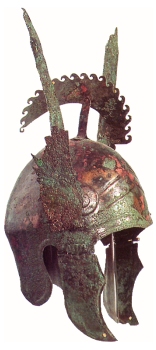 An impressive Osco-Attic helmet of the Samnites.
An impressive Osco-Attic helmet of the Samnites.
 The standard type of Attic(Athenian) helmet of the Roman officers until the fall of the Roman Empire.
The standard type of Attic(Athenian) helmet of the Roman officers until the fall of the Roman Empire.
–
At the same time the peoples of Italy used alongside the original Greek types, with almost the same frequency with which they used the Italo-Corinthian and Italo-Attic types. In contrast, those types did not become popular among the Greeks of Italy (Magna Graecia) and Sicily, while their rather rare presence in mainland Greece and the Hellenistic World is due more to a number of Etruscan and Oscan mercenaries in these countries and later to the Roman campaigning and garrison troops in them.
–
–
FURTHER READING
– Cristofani M., I bronzi degli Etruschi
– RASENNA, of the series ANTICA MADRE
– ITALIA. Omnium terrarum alumna, of the series ANTICA MADRE
– Rita Benassai, La pittura dei campani e dei sanniti
– Titus Livius, Ab Urbe Condita (Roman History)
A Chalkidean bronze helmet, the ancestor of the Attic and Osco-Attic helmets. The typical Chalkidean helmet was also popular among the Italian Peoples.
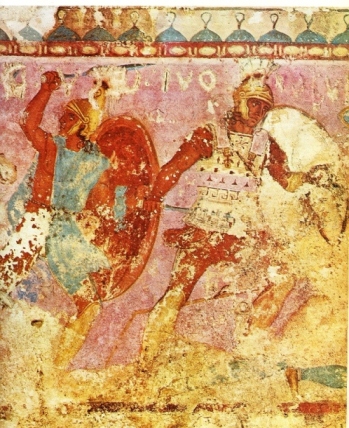
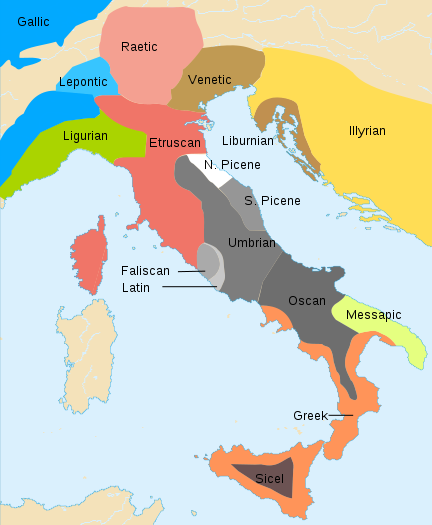
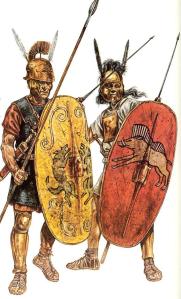
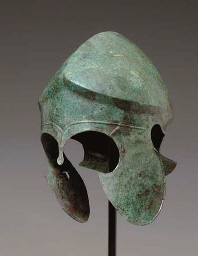







Leave a comment